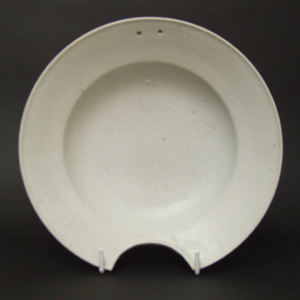
NANKING CARGO c.1750 Japanese Porcelain
A Rare Private Trade Nanking Cargo Japanese White Barber`s Bowl from the Wreck of the Geldermalsen c.1750.
SOLD
- Condition
- No damage, the glaze some what degraded.
- Size
- Diameter : 27.5 cm (10 3/4 inches).
- Provenance
- The Nanking Cargo, Chinese Export Porcelain and Gold. Christie`s Amsterdam (28th April-2nd of May 1986) lot 3244, sold for 4,060 guilders. The Collection of Henry Woods-Wilson.
- Stock number
- 21988
Information
Japanese Porcelain from the Nanking Cargo :
Although 10`s of thousands of pieces of Chinese porcelain were recovered from the wreck of the Geldermalsen only four pieces of Japanese porcelain were excavated from the wreck. We are pleased to have three of these pieces for sale now, they are from the collection of Henry Woods-Wilson. The Japanese pieces from the cargo are all different, although two are barber`s bowls of the same size and form. They are clearly `Private Trade` pieces, distinct from the main cargo, the V.O.C. allowed a certain amount of private trading by the crew. These rare pieces recovered from the wreck provide a valuable insight into the Japanese porcelain being produced at the same time as the blue and white Chinese porcelain we refer to as `Nanking Cargo`.
Barber`s Bowls :
This form originates in Europe and was in popular use during the 17th and 18th centuries. Despite its name it has nothing to do with hair-cutting. They were used by barbers for shaving and by barber-surgeons for blood-letting, the indented area of the rim allowed the bowl to be kept in close proximity to the neck for shaving or the arm for blood-letting. Many were made of metal, usually pewter or brass, as metal was a more robust material for a functional object but there were lots ceramic examples made too. English and Dutch Delftware barber`s bowls were made throughout this period, most were decorated in blue and white, but the Dutch also liked plain white Delft barber`s bowls. They were more than just purely functional objects, they enlivened barber`s shop, some even had the tools of the trade or an inscription relating to their function incorporated as part of the design. The top of the bowl or the footrim would be pierced so they could be hung up in the shop. This kept them out of harms way but also served to decorate the shop. Chinese and Japanese export porcelain barber`s bowl were made from the very end of the 17th century but most date to the first half of the 18th century. They were decorated in either blue and white, imari, Famille Rose or Famille Verte.
The Geldermalsen :
The Geldermalsen built in 1746 was one of the newest and finest Dutch East Indiamen. It is one hundred and fifty feet long and forty-two feet wide. Captain Jan Morel, 33 years old, his many Dutch sailors and sixteen Englishmen set sail from Canton. On Monday January 3rd 1752 the Geldermalsen on its way to Holland hit a reef and sank. The survivors struggle on in a barge and long boat and reach Batavia in eight days. The wreck held a most valuable cargo of tea, as well as Chinese silks and textiles. All now lost. The vast porcelain cargo, as well as gold has survived. Tea was the real reason for the journey, ceramics accounting for only five per cent of the total value. The loss of the Geldermalsen cost the Dutch East India Company 900.000 guilders. However the porcelain from the sister ship the Amstelveen sold for far more than normal because it now carried all the porcelain to be sold in Holland that year. See `History` for more information about the Geldermalsen and other shipwrecks.

